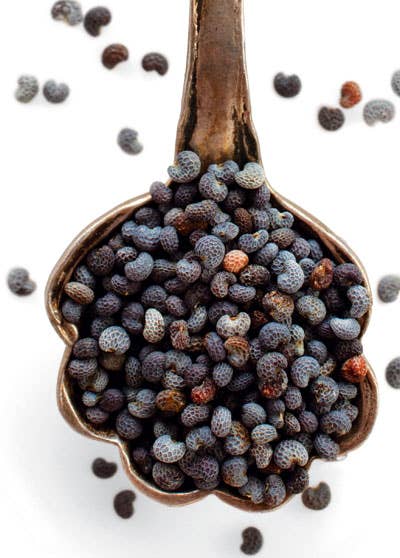
I've always loved poppy seeds. My first taste of them came courtesy of my grandfather, Abram Gershenson, who brought a delicious repertoire of Eastern European baked goods with him from Russia to the U.S. when he emigrated with my grandmother, Klara, in 1979. My favorite among them was mak pirog, which translates literally as poppy seed pie, a yeast dough roulade swirled with a moist, black filling of ground poppy seeds, sugar, and raisins. I could gobble slice after slice without putting a dent in my appetite; my love for it was compulsive. Yet to this day, I have difficulty pinpointing the precise flavor of that filling: sweet and vaguely floral, but dark, too, with hints of earth and nuts. It's like no other food I know.
Even as a kid, I realized that poppy seeds, apart from their occasional scattering on a bagel or a kaiser roll, in a sweet vinaigrette, or in those ubiquitous lemon-cake muffins, didn't get much recognition. With the notable exception of hamantaschen, the triangle-shaped cookies with poppy seed filling I ate in Hebrew school every Purim, I rarely ate them outside our home. Even still, they became an object of affection.
A few years ago at Al Di La, a fantastic Italian restaurant in Brooklyn, I discovered casunziei, beet ravioli in a poppy seed—flecked butter sauce. I was surprised to learn that it's one of many northern Italian dishes made with poppy seeds, a legacy of the Austro-Hungarian Empire and its cuisine, which has long used the seeds in sweet and savory ways. At home a few days later, I made a rich sauce for tagliatelle by heating poppy seeds in butter, along with shallots, wine, and cream. Their flavor bloomed in the fat, giving the entire dish a subtly woodsy taste.
But it wasn't until I was in the Czech Republic recently that I really came to understand what poppy seeds are and where they come from. The country is not only one of Europe's largest producers of poppy seeds, but its cuisine has embraced them wholeheartedly—in yeast-dough pastries called kolače, sprinkled liberally over potato gnocchi and fruit-filled dumplings, as a filling for crepes, and combined with blueberries and spread over a shortbread crust in borůvkový kolač, my favorite Czech pastry.
In the village of Ostředek, just southeast of Prague, I found myself standing waist-deep in a 100-acre field of Papaver somniferum, poppy plants. If I had come a few weeks earlier, they would have been in full bloom, papery petals of white streaked with lilac (the wild red poppies we tend to think of, Papaver rhoeas, do not produce seeds for culinary use). Instead, capping the tall, thick stems were spherical seedpods in an incandescent blue-green shade. The alarming color held a clue to the plants' other use: If the exterior of the pod is scored, the wound oozes white latex sap, better known as opium.
I broke open one of those pods, knocked out a handful of ruddy brown seeds into my palm, and stared with disbelief as they turned a cloudy lavender before my eyes, a response to the sudden oxidation. This, I learned, means the seeds aren't quite ripe. When they're ready to harvest, they emerge from the pod looking pretty much the way they do on a bagel: smoky blue-black. I tossed them into my mouth and savored their complex flavor: like legumes, like fresh peas, like hazelnuts, like flowers. The flavor is a contradiction—floral yet earthy, evanescent yet grounded.
Our taste for poppy seeds stretches back to pre-ancient times. According to Mark Merlin, author of On The Trail of the Ancient Opium Poppy (Farleigh Dickenson University Press, 1984), the cultivation of poppy seeds dates to the Neolithic period in Europe. White poppy seeds, from Papaver somniferum album, are most commonly used in Asia; they're smaller and milder tasting than the blue-black variety. I was particularly fascinated to read about the use of white poppy seeds in Bengali cuisine while reading Eating India (Bloomsbury USA, 2007), by food historian Chitrita Banerji. Their abundance in the region was linked to the rampant opium trade of the 18th and 19th centuries, when British colonists insisted that Bengali farmers turn their arable land over to farming poppies. Though the flowers were cultivated for narcotics, a by-product of the crop was poppy seeds, which Bengalis incorporated into their cuisine. In one classic Bengali dish, aloo posto, potatoes are cooked with a fine paste made from poppy and mustard seeds pureed with garlic, chile, water, and salt. Even combined with those strong flavors, the singular, nutty, vaguely floral taste of the poppy seeds comes through.
I noticed one thing that this dish has in common with my beloved mak pirog: the grinding of the seeds. Though plenty of recipes call for seeds to be added whole, which lends color, crunch, and mellow earthy flavor, grinding the seeds releases their fragrant oil, which makes for a moister, more intensely flavored filling. I learned later in life why my grandfather didn't make mak pirog for every visit: It's a lot of work. To make the filling, he would soak the poppy seeds in water overnight to soften the crunchy hull, and then process them twice through a meat grinder, releasing as much of the oil as possible. He would next simmer the seeds with water and sugar, and then raisins, stirring until they absorbed the liquid and clung together, like fertile soil. It was dark, mysterious, delicious—everything I love about poppy seeds.
Keep Reading
Continue to Next Story










